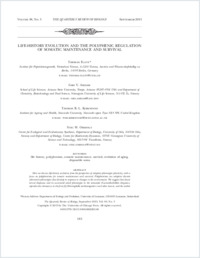Life-history evolution and the polyphenic regulation of somatic maintenance and survival
- Flatt, Thomas Institut für Populationsgenetik, Vetmedunim Vienna, Austria
- Amdam, Gro V. School of Life Sciences, Arizona State University, Tempe, USA - Department of Chemistry, Biotechnology and Food Science, Norwegian University of Life Sciences, Norway
- Kirkwood, Thomas B. L. Institute for Ageing and Health, Newcastle University, United Kingdom
- Omholt, Stig W. Centre for Ecological and Evolutionary Synthesis, Department of Biology, University of Oslo, Norway - Department of Biology, Centre for Biodiversity Dynamics, Norwegian University of Science and Technology, Trondheim, Norway
-
01.09.2013
Published in:
- The Quarterly Review of Biology. - 2013, vol. 88, no. 3, p. 185–218
English
Here we discuss life-history evolution from the perspective of adaptive phenotypic plasticity, with a focus on polyphenisms for somatic maintenance and survival. Polyphenisms are adaptive discrete alternative phenotypes that develop in response to changes in the environment. We suggest that dauer larval diapause and its associated adult phenotypes in the nematode (Caenorhabditis elegans), reproductive dormancy in the fruit fly (Drosophila melanogaster) and other insects, and the worker castes of the honey bee (Apis mellifera) are examples of what may be viewed as the polyphenic regulation of somatic maintenance and survival. In these and other cases, the same genotype can—depending upon its environment—express either of two alternative sets of life-history phenotypes that differ markedly with respect to somatic maintenance, survival ability, and thus life span. This plastic modulation of somatic maintenance and survival has traditionally been underappreciated by researchers working on aging and life history. We review the current evidence for such adaptive life-history switches and their molecular regulation and suggest that they are caused by temporally and/or spatially varying, stressful environments that impose diversifying selection, thereby favoring the evolution of plasticity of somatic maintenance and survival under strong regulatory control. By considering somatic maintenance and survivorship from the perspective of adaptive life-history switches, we may gain novel insights into the mechanisms and evolution of aging.
- Faculty
- Faculté des sciences et de médecine
- Department
- Département de Biologie
- Language
-
- English
- Classification
- Biological sciences
- License
-
License undefined
- Identifiers
-
- RERO DOC 324284
- DOI 10.1086/671484
- Persistent URL
- https://folia.unifr.ch/unifr/documents/307707
Statistics
Document views: 112
File downloads:
- pdf: 301
